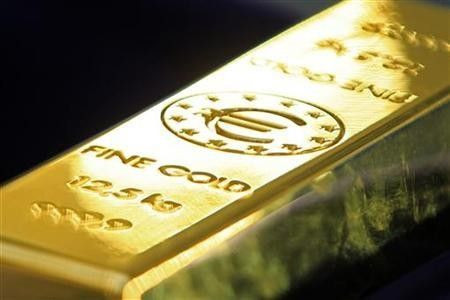Gold falls 1 percent as Obama announces debt deal

Gold fell more than 1 percent on Monday after President Barack Obama said lawmakers had reached a deal to cut the country's deficit, which, if approved, would remove the threat of a default on debt that has driven bullion to a record high.
But the hit to gold and relief in financial markets over the deal may be short-lived due to a bleak macroeconomic outlook.
Gold's allure as a shelter from economic storms remains strong as China's factories struggled with their weakest activity in 28 months in July and sovereign debt concerns continued to wrack the euro zone.
The most-active U.S. gold futures fell more than 1 percent to $1,608.2, but recovered to trade down 0.9 percent at $1,616 an ounce by 0634 GMT.
Spot gold fell 0.8 percent to $1,613.24, off a record high of $1,632.30 set on Friday.
"The fact that the framework is now available and lawmakers are close to an agreement is reducing the safe-haven flow to gold," said Ong Yi Ling, an analyst at Phillip Futures.
"People are still waiting to see details and whether the plan will pass the vote of the Congress."
The U.S. Senate is likely to vote on Monday on the proposed agreement between Democrats and Republican leaders to reduce the U.S. deficit and avoid default.
"People are selling gold as it seems a done deal now," said a Singapore-based trader.
A firmer dollar following the end of the lengthy and frustrating debt ceiling talks could further pressure gold priced in the greenback.
While the deal removes the immediate threat of a first ever U.S. default, the repercussions of the acrimonious talks are likely to reverberate for years to come.
The U.S. still faces the prospect of paying more to service its debt as it is unclear if the deal is enough to appease credit ratings agency S&P, which has threatened to strip the world's largest economy of its top-notch AAA rating.
Speculators sold ahead in anticipation that U.S. politicians would cut a deal, reducing long positions in gold last week, even as bullion rallied to record highs, the U.S. Commodity Futures Trading Commission data showed.
Gold rose 8.5 percent in July, its best month since April, as investors sought safety from debt problems on both sides of the Atlantic.
GOLD RETAINS LONG-TERM APPEAL
"Don't forget there's Europe in the background with problems in Italy and Spain," said Natalie Robertson, a commodities analyst at ANZ. "There is still heightened risk aversion in the market and gold will probably be volatile in the next few days."
Last week, rating agency Moody's put Spain on review for a possible downgrade, adding to concerns that a Greek rescue package has done little to halt the spread of Europe's debt crisis.
U.S. economic growth remains a concern. Data last week showed that growth in the world's largest economy in the first half of the year was much slower than expected.
The psychological $1,600-level is a key support for gold prices. Gold could retrace another $20 to $30 if that level is breached, traders and analysts said.
Bargain hunters would probably emerge if the price drops, as economic woes lead some investors to bet on the long-term bullish view on gold.
Platinum group metals declined, tracking the weakness in gold.
Spot platinum dropped to a low of $1,771.49, before gaining some lost ground to trade at $1,790.99, down 1.1 percent from the previous close.
Spot palladium lost 0.4 percent to $836.97.
© Copyright Thomson Reuters 2024. All rights reserved.




















